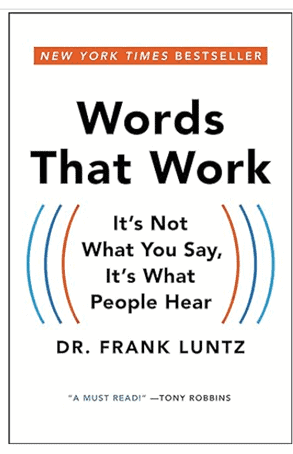By Jim Heffernan
This book grabbed me from the beginning, but my first impulse was not to review it. I wanted to keep it as my own precious secret. Jiminy* had a word with me, and I realized it would be wrong for me not to share it.
Whether it’s speaking or writing, Dr. Luntz can teach anyone to enhance the power of the message.
Frank Luntz was a name familiar to me. By reputation, I thought of him as a villain who supplied Republicans with a list of words so they could use say one thing and mean another. He did that, but it was just a by-product of his research. He consults with anyone who can pay for his services. He helps them find ways of using language effectively. He has worked with advertisers, corporations, Republicans, and Democrats.
A prime example of what he does is not using the terms “estate taxes” and “inheritance taxes” swapping them with the new term, “death taxes”. “Death taxes” worked better and provided political traction for those who wished to keep more wealth in the upper class.
There’s a fascinating section, beginning of page 48, about him helping Rep Al Ford, Jr. craft the key-note speech for Al Gore’s nomination.
His book could by largely summarized as “There are ten rules of effective communication: 1. Simplicity, 2. Brevity, 3. Credibility, 4. Consistency, 5. Novelty, 6. Sound, 7. Aspiration, 8. Visualization, 9. Questioning and 10. Context” He enlarges on each of the terms throughout the book.
Here’s an excerpt from conclusion. It impresses me, the linkage between our language and the way we treat each other.
For most people, language is functional rather than being an end in itself. For me, it’s the people that are the end; language is just a tool to reach them, a means to an end. But it’s not enough to simply stand there and marvel at the tool’s beauty … you must realize that it’s like fire, and the outcome depends on how it is used … to light the way … or to destroy.
The real problem with our language today is that it’s been so coarsened. Words and expressions once considered horribly vulgar have become a part of the common parlance, their original meanings all but forgotten. Six-year-olds say “That sucks” (a crude reference to oral sex), and we giggle at how cute and precocious they are. Adults throw around terms like “scumbag” (literally, “a used condom”) without a second thought. And that’s the problem as I see it-our language has become so unimportant and disposable that we feel we can say anything we want whenever we want to, and after it is spoken, it disappears into the ether.
Beyond the vulgarity of such talk, there’s a harshness to it-a disturbing discourtesy, even viciousness, that’s relatively new in American life.
We seek out words to divide, to demean, to preempt a setup with a put-down. Negativity feels more pervasive than ever before. I hate it, and so I’ve dedicated myself to finding the positive in politics and products rather than identifying the faults of others. Surrounded by such meanness and abrasiveness, there is much to be gained by being upbeat and optimistic. When you trash the opposition, you simultaneously demean yourself. The best warrior is a happy warrior. Accentuate the positive … eliminate the negative. Negative definitely works, but a solid positive message will triumph over negativity.
Acceptable language varies and changes. The n-word on a sitcom thirty years ago was very edgy but acceptable, but not so in this day and age. Conversely, the slang for certain body parts that would have never made it past network censors a generation ago are heard on television constantly nowadays. Know your audience. Challenge them but don’t offend them.
483 pages, (50 acknowledgements, etc.) Publ. January 2,2007
Available Cloud and Leaf Bookstore, Manzanita
As always, discussion is welcome at codger817@gmail.com
*Jiminy is an avatar for my conscience. I stole it from the “Pinocchio” character Jiminy Cricket.


